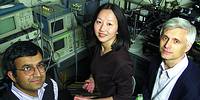Researchers develop the first plastic superconductor
9 May 2001
News
Scientists from Bell Labs have created a superconducting plastic material. The plastic is an inexpensive material that could be widely used in the future for applications, such as quantum computing and superconducting electronics, say the researchers.
The Bell Labs breakthrough was made possible by a multidisciplinary team of researchers, whose backgrounds range from experimental low-temperature physics to materials science and organic chemistry.
The challenge in creating a plastic superconductor was overcoming the inherent structural randomness of a polymer - similar to strands of cooked spaghetti - which prevented the electronic interactions necessary for superconductivity. The Bell Labs scientists were able to overcome this by making a solution containing the plastic, polythiophene. They then deposited thin films of it onto an underlying layer so that the polymer molecules stacked up against one another like uncooked spaghetti. Instead of adding chemical impurities to change the material's electrical properties, as is often done, the researchers used a novel technique in which they removed electrons from polythiophene.
The temperature below which polythiophene became superconducting was -270°C and the scientists are optimistic that they can raise the temperature in the future by altering the molecular structure of the polymer. "Using the same methods, the scientists believe that many organic materials could potentially now be made superconducting," said Zhenan Bao, a Bell Labs chemist who was involved in the research.
Scientists Zhenan Bao, Ananth Dodabalapur and Christian Kloc were part of a Bell Labs team that produced the world's first plastic superconductor
"A new window into nature has opened up," said Ananth Dodabalapur, a Device Physicist at Bell Labs and member of the research team, talking of the implications of the breakthrough.
Besides Bao and Dodabalapur, Bell Labs scientists involved in the research were Hendrik Schon, Christian Kloc and Bertram Batlogg. A collaborator from the University of Konstanz in Germany, Ortwin Schenker, also participated in the research. In addition to Bell Labs, Batlogg is affiliated with the solid state physics laboratory at ETH Honggerberg in Switzerland.
Bell Labs scientists have received six Nobel Prizes in Physics, nine US Medals of Science and six US Medals of Technology.
For more information about Bell Labs, visit its website at www.bell-labs.com
Further reading:
Electronic News Digest
News
A brief synopsis of current global news relating to the electronic engineering fields with regards to company finances, general company news, and engineering technologies.
Read more...
4000 A containerised DB for power project
News
Power Process Systems has successfully completed the design, fabrication, and commissioning of a 4000 A containerised distribution board for a wind/PV solar hybrid renewable energy project.
Read more...
Datacentrix Industrial Indaba 2025
News
Datacentrix recently hosted its inaugural Industrial Indaba 2025, where industry leaders explored how digitalisation, resilience, security and compliance are shaping the future of sustainable industrial operations in Africa.
Read more...
RS brings solar light to 150 000 people
RS South Africa
News
The company’s three-year partnership with SolarAid aims to raise £1 million through corporate donations, matched funding, product contributions, and fundraising to accelerate access to safe, sustainable energy.
Read more...
Microchip and AVIVA Links collaboration
Altron Arrow
News
Microchip and AVIVA Links have achieved groundbreaking ASA-ML interoperability, accelerating the shift to open standards for automotive connectivity.
Read more...
World’s leading supplier of grid automation products
News
Hitachi Energy was recognised as the global market share leader in grid automation for electric power transmission and distribution utilities by ARC Advisory Group.
Read more...
Vivashan Muthan appointed as head of export sales and operations at RS South Africa
RS South Africa
News
With a career spanning engineering, business development, and sales leadership across sub-Saharan Africa, Vivashan Muthan brings a wealth of expertise to his new role as head of export sales and operations.
Read more...
Google equips university students across Africa with free access to advanced AI tools
News
A 12-month Google AI Pro plan has been launched for students in Ghana, Kenya, Nigeria, Rwanda, South Africa, and Zimbabwe to build foundational AI skills.
Read more...
Africa’s space economy projected to be worth $22,6 billion in 2026
News
South Africa is gearing up to be at the forefront of the growth in the space industry, creating thousands of jobs, driving innovation, and boosting the national economy.
Read more...
Distribution partnership with MacDermid Alpha
Testerion
News
MacDermid Alpha Electronics Solutions India Private Limited has announced that as of 01 September 2025 Testerion will be the sole importer and distributor of their products to the South African market.
Read more...


